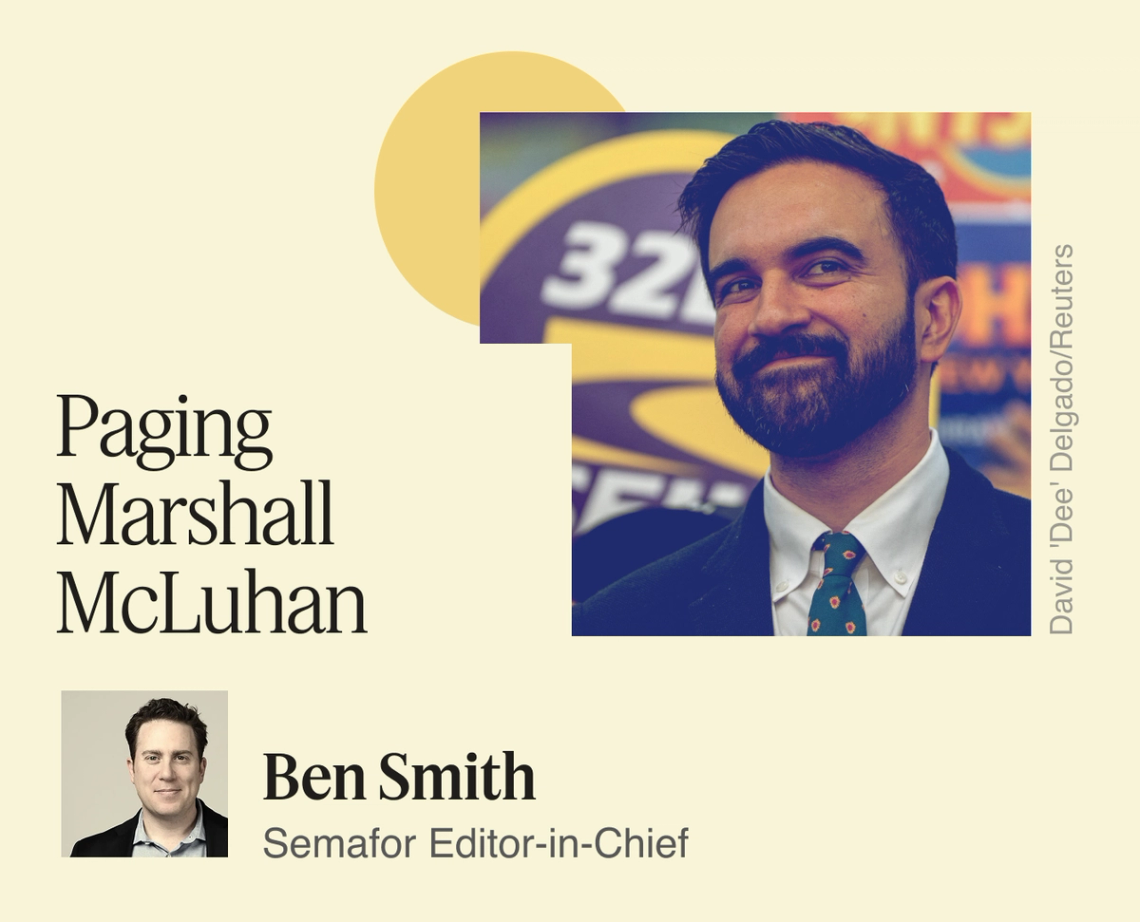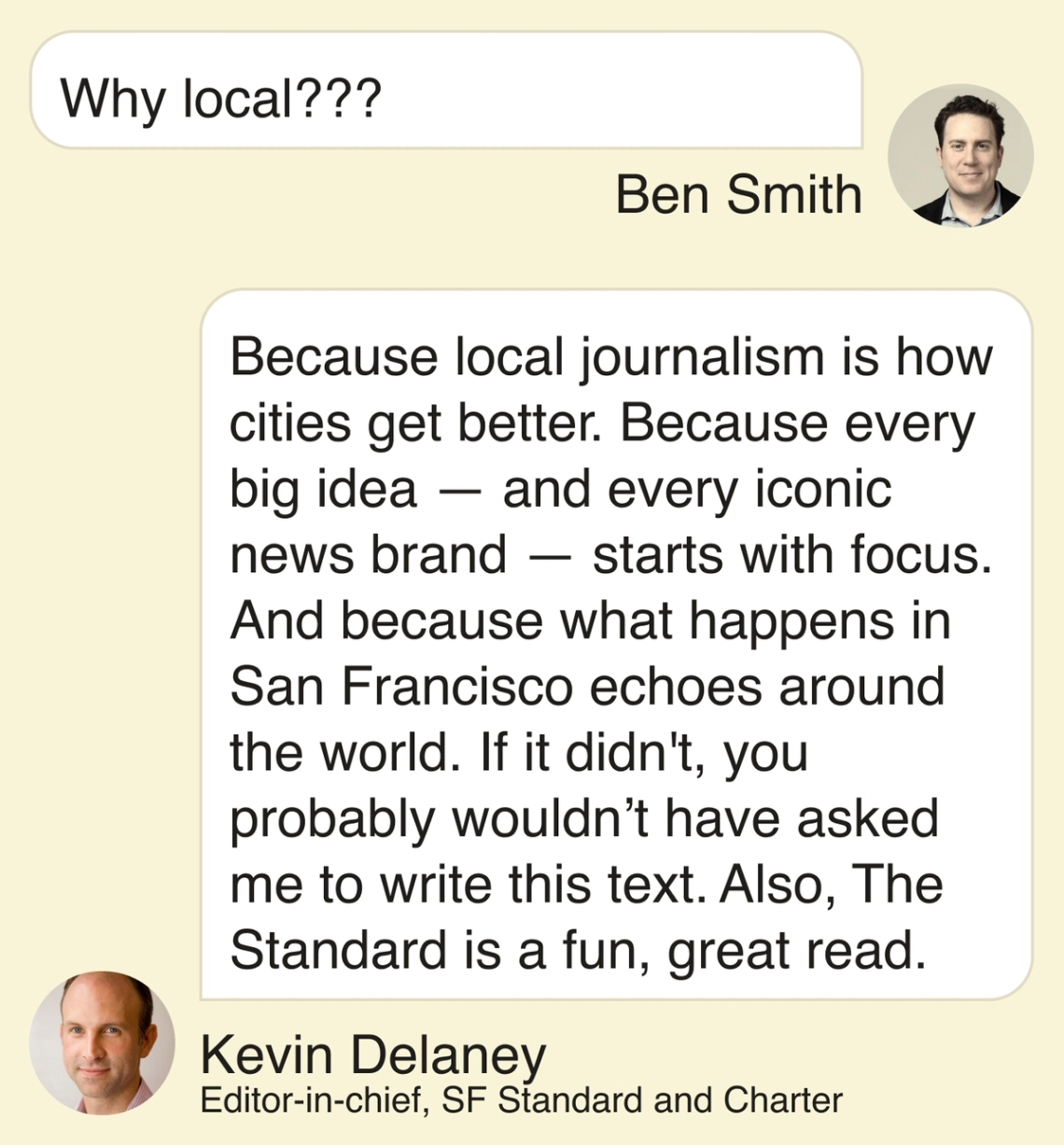| | In today’s edition: Zohran Mamdani and the Times.͏ ͏ ͏ ͏ ͏ ͏ |
| |   New York New York |   Washington Washington |   San Francisco San Francisco |
 | Media |  |
| |
|
 - The Times and Mamdani
- Punchbowl video
- Fortune and Axios turn to AI
- Passive consumption
- Mixed Signals
|
|
 How does the medium shape the message? Ezra Klein and Chris Hayes recently debated whether vertical video is intrinsically less toxic than text-y social media. Zohran Mamdani’s media consultant, Morris Katz, joined us on Mixed Signals to discuss what worked for the Democratic New York City mayoral nominee, and noted that “people are not scrolling through social media to feel worse.” Mamdani’s earnest, sometimes silly good cheer played well in an entertainment medium — as, by the way, does the Trump dance. But while Mamdani’s savvy media strategy allowed him to dominate the primary campaign, controlling the narrative during the general election, and if and when he takes office in America’s media capital, will prove a more daunting challenge. And as the reaction to The New York Times’ story about Mamdani’s Columbia application shows, the legacy media still thinks it has a say. Also today: Punchbowl’s video plans, and Fortune and Axios’ new AI rules. (Scoop count: 3) |
|
Times raced Rufo on Mamdani Columbia story |
 David ‘Dee’ Delgado/Reuters David ‘Dee’ Delgado/ReutersThe Times’ story last week about Mamdani’s application to Columbia University in 2009 — in which the paper reported that the Uganda-born Democratic nominee for New York City mayor identified his race on a form as both “Asian” and “Black or African American” — came as the result of the release of hacked Columbia University records that were then shared with the Times. It was also competitive: The paper did not want to be scooped by the independent journalist Christopher Rufo, who was also chasing the story, two people familiar with the reporting process told Semafor. In a message, Rufo, best known as a right-wing voice fighting “wokeness” on campus, confirmed to Semafor that he had been reporting out the piece before the Times published its version of the story. A spokesperson for the paper declined to comment on whether Rufo’s reporting prompted the paper to push the piece out on Thursday, and pointed Semafor to a statement it first provided to the Columbia Journalism Review outlining its reasons for publishing the piece. “What matters most here is whether the information was true and factual — it was, confirmed by Mr. Mamdani; that it was independently confirmed; and that it is relevant to the public,” said Patrick Healy, assistant managing editor for standards and trust at the Times. |
|
 Screenshot/Punchbowl News Screenshot/Punchbowl NewsThe Capitol publication Punchbowl News will launch a weekly YouTube show called Fly Out Day — a test of whether the shift toward video that is underway across other forms of media will work in the text-heavy and information-hungry Washington market, where network Sunday shows remain the premier video product. Fly Out Day will be a “modern political show that is very in-the-moment and focused on the politics of legislating,” said Punchbowl CEO Anna Palmer, who is co-hosting the show with her scoopy co-founder Jake Sherman. They’ll feature “sharp interviews with key newsmakers and roundtable conversations with plugged-in reporters,” but they “don’t want it to look like anything on TV,” she said, adding that Punchbowl has pre-sold advertising. As for the name: It’s the end of the week, when lawmakers head home — and stop by Punchbowl’s studio on the way. From my vantage point here at Semafor’s vast DC studio, I cringe a bit to recall various early stops and starts in DC insider video. At Politico, where Jake, Anna and I all worked, I participated in a painful 2007 version I’m appalled is still online, and wrote credulously about a live launch way back in 2012 (headline: “Political Web TV Comes of Age”). Politico now also has a new politics show. But the moment is shifting. TV-like shows are resurgent on new platforms, and we wish our Punchbowl friends luck making a market as we start to prepare our own Burgess Everett for hair and makeup. — Ben Smith |
|
Fortune and Axios warm to AI |
 Fortune/Axios/Illustration Fortune/Axios/IllustrationMedia companies are continuing to push the boundaries of how AI can be incorporated into journalism. Last week, Fortune told staff that it would be amping up its AI-produced content. According to an internal memo shared with Semafor, the company said it’s bringing back former editor Nick Lichtenberg to “test ways to use AI to deliver breaking news faster” with a new section called Fortune Intelligence — essentially, stories co-written with chatbots, though the memo repeatedly stressed that “human oversight is required at every stage before publication.” The goal, the memo said, is to get Fortune closer to being a “site of record” and a daily habit for readers. Staff will also use AI to generate graphics, and to turn one of the newsletters into a podcast. “We intend to surf this wave, not get pummeled by it,” EIC Alyson Shontell wrote. Axios is also loosening its prohibition on AI-written stories. New internal editorial guidelines first shared with Semafor showed that the digital publisher is relaxing its old policy, which had required all content to “be written or produced by a real person with a real identity.” “That was written years ago and was unnecessarily limiting as we’ve learned more about what AI tools can and can’t do,” the new guidance said. — Marta Biino and Max Tani |
|
Turned off, tuned out, logged in |
 About 60% of Americans proactively seek out the news, according to a Global Strategy Group survey out late last month. The rest are what the poll’s authors call “passive” consumers — people who say the news “comes to me.” The difference is starkest for members of the youngest 18-to-29 age bracket, who also reported getting a greater share of their news from social media. Passive news consumers preferred President Donald Trump over Kamala Harris in the 2024 election, but a bare majority now say they disapprove of him. One place these tuned-out viewers still go: YouTube, which 80% — and 95% of 18-to-29-year-olds — said they used at least weekly. — Graph Massara |
|
 The secret to Zohran Mamdani’s winning strategy is simpler than you think. The once-little-known lawmaker shocked New York by winning the Democratic primary for mayor — thanks in large part to vertical videos that actually broke through. This week on Mixed Signals, Ben and Max talk to the candidate’s media team, Rebecca Katz, founder of the political ad agency Fight, and Morris Katz (no relation), the lead media strategist for the campaign. They get the behind-the-scenes scoop on how viral videos like “Halalflation” came about, why Mamdani’s videos worked, and what future political campaigns can learn from his success. Listen to the latest episode of Mixed Signals now. |
|
Kevin Delaney is the newly-appointed editor-in-chief of the San Francisco Standard, as well as editor-in-chief of Charter, a business news site that the Standard recently acquired.  |
|
 NBC News is dispatching its full team to Texas tomorrow to cover the horrific weekend floods. Savannah Guthrie will host the Today show on the ground, and new Nightly anchor Tom Llamas will also be in the state broadcasting live Monday evening … Semafor asked The Atlantic about a widespread rumor within the Times that the magazine had also been tipped off to the Zohran Mamdani college admissions story, but had ultimately decided to pass; the magazine declined to comment ... Critics of Paramount’s decision to settle with President Donald Trump this week are watching to see whether former CBS News President Wendy McMahon or former 60 Minutes producer Bill Owens decide to voluntarily testify in the California legislature’s probe of the settlement… |
|
  Jonathan Ernst/Reuters Jonathan Ernst/ReutersWith the final passage of the GOP megabill through Congress this week, the Republican Party won a generational victory. And they did it by co-opting some of Democrats’ strongest messages — promises to improve federal health care programs and prioritize the neediest Americans — to pass a bill that will cut Medicaid access. “Republicans have talked a big game about becoming the party of working people,” Texas Rep. Greg Casar, the chair of the Congressional Progressive Caucus, told Semafor’s David Weigel. “This vote should be the final nail in the coffin of that idea.” |
|
|